Assessing the Effectiveness of Ecological Mitigation Practices in Public Construction with a Quick and Operational Assessment Framework
Abstract
1. Introduction
2. Case Study
3. The Developed Ecological Performance Assessment Framework
4. Results and Discussion
4.1. The Results of Assessment Indicators
4.2. Development of the Evaluation Standard for Ecological Performance
4.3. Comparison of the Proposed Framework to Existing Assessment Methods
5. Conclusions
Author Contributions
Funding
Institutional Review Board Statement
Informed Consent Statement
Data Availability Statement
Conflicts of Interest
Appendix A
| Number | Construction Types | Ia | Im | Io | Ih | Total Points |
|---|---|---|---|---|---|---|
| 1 | River conservation | 10 | 10 | 0 | 0 | 20 |
| 2 | River conservation | 10 | 10 | 0 | 0 | 20 |
| 3 | River conservation | 8 | 10 | 0 | 0 | 18 |
| 4 | River conservation | 8 | 10 | 0 | 0 | 18 |
| 5 | River conservation | 10 | 10 | 3 | 0 | 23 |
| 6 | River conservation | 10 | 10 | 10 | 0 | 30 |
| 7 | River conservation | 0 | 10 | 0 | 0 | 10 |
| 8 | River conservation | 0 | 10 | 0 | 0 | 10 |
| 9 | River conservation | 10 | 10 | 0 | 5.75 | 25.75 |
| 10 | River conservation | 8 | 10 | 0 | 5.25 | 23.25 |
| 11 | River conservation | 0 | 10 | 3 | 5.25 | 18.25 |
| 12 | River conservation | 10 | 10 | 3 | 0 | 23 |
| 13 | River conservation | 0 | 10 | 0 | 8.25 | 18.25 |
| 14 | River conservation | 8 | 10 | 10 | 5.75 | 33.75 |
| 15 | River conservation | 8 | 10 | 0 | 5.5 | 23.5 |
| 16 | River conservation | 0 | 10 | 3 | 6.5 | 19.5 |
| 17 | River conservation | 0 | 10 | 3 | 8.25 | 21.25 |
| 18 | Slope land conservation | 10 | 10 | 5 | 0 | 25 |
| 19 | Slope land conservation | 8 | 10 | 0 | 0 | 18 |
| 20 | Slope land conservation | 10 | 10 | 0 | 0 | 20 |
| 21 | Slope land conservation | 10 | 10 | 3 | 0 | 23 |
| 22 | Slope land conservation | 10 | 10 | 0 | 0 | 20 |
| 23 | Slope land conservation | 10 | 10 | 0 | 0 | 20 |
| 24 | Slope land conservation | 10 | 10 | 0 | 0 | 20 |
| 25 | Slope land conservation | 8 | 10 | 0 | 0 | 18 |
| 26 | Slope land conservation | 8 | 10 | 5 | 0 | 23 |
| 27 | Slope land conservation | 0 | 10 | 0 | 0 | 10 |
| 28 | Slope land conservation | 0 | 10 | 0 | 0 | 10 |
| 29 | River and reservoir dredging | 8 | 5 | 0 | 0 | 13 |
| 30 | River and reservoir dredging | 10 | 8 | 5 | 0 | 23 |
| 31 | River and reservoir dredging | 8 | 8 | 0 | 0 | 16 |
| 32 | River and reservoir dredging | 10 | 10 | 0 | 9.5 | 29.5 |
| 33 | River and reservoir dredging | 8 | 10 | 8 | 6 | 32 |
| 34 | River and reservoir dredging | 10 | 10 | 0 | 9 | 29 |
| 35 | River and reservoir dredging | 10 | 10 | 5 | 6.5 | 31.5 |
| 36 | River and reservoir dredging | 10 | 10 | 8 | 6.5 | 34.5 |
| 37 | Structure improvement | 10 | 10 | 5 | 0 | 25 |
| 38 | Structure improvement | 10 | 10 | 5 | 0 | 25 |
| 39 | Structure improvement | 10 | 10 | 5 | 0 | 25 |
| 40 | Structure improvement | 10 | 10 | 5 | 0 | 25 |
| 41 | Structure improvement | 10 | 10 | 0 | 0 | 20 |
| 42 | Structure improvement | 10 | 8 | 3 | 0 | 21 |
| 43 | Others | 10 | 8 | 0 | 0 | 18 |
| 44 | Others | 10 | 5 | 0 | 0 | 15 |
| 45 | Others | 10 | 10 | 8 | 0 | 28 |
| 46 | Others | 10 | 10 | 5 | 9 | 34 |
| 47 | Others | 10 | 10 | 3 | 9 | 32 |
| 48 | Others | 0 | 10 | 0 | 0 | 10 |
| 49 | Others | 0 | 10 | 0 | 0 | 10 |
| 50 | Others | 10 | 3 | 0 | 0 | 13 |
| 51 | Others | 10 | 8 | 0 | 0 | 18 |
| 52 | Others | 10 | 10 | 0 | 8.75 | 28.75 |
| 53 | Others | 8 | 10 | 10 | 9 | 37 |
| 54 | Others | 8 | 10 | 0 | 6 | 24 |
| Assessment Indicators | Description | |||
|---|---|---|---|---|
| Percentage of woody plant coverage (%) | The percentage of the sample area covered by trees and shrubs in the assessment area. Woody plants are generally considered to take longer to grow than herbs, and areas with dense woody plant growth are often considered to be at a later stage of succession and in good vegetative condition. | |||
| Optimal (4 points) | Sub-optimal (3 points) | Fair (2 points) | Unsatisfactory (1 point) | |
| 55 or more | 15~55 | 0~15 | 0 | |
 |  | 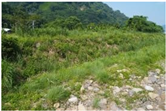 |  | |
| Number of plant species (number/100 m2) | The more diverse the vegetation species are, the higher the plant diversity of the area is. | |||
| Optimal (4 points) | Sub-optimal (3 points) | Fair (2 points) | Unsatisfactory (1 point) | |
| 30 or more | 20~30 | 15~20 | 15 or less | |
 |  |  |  | |
| Native plant coverage (%) | The percentage of the sample area covered by all native species in the sample area represents the percentage of the sample area covered by all native species in the sample area. | |||
| Optimal (4 points) | Sub-optimal (3 points) | Fair (2 points) | Unsatisfactory (1 point) | |
| 65 or more | 30~65 | 10~30 | 10 or less | |
 |  |  |  | |
| Structure layers of plant community | More layers cause a more complex phytosocial composition, and it is more likely to be a natural forest environment. | |||
| Optimal (4 points) | Sub-optimal (3 points) | Fair (2 points) | Unsatisfactory (1 point) | |
| With more than four-layer structure | With three-layer structure | With two-layer structure | With one-layer structure or exposed | |
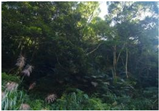 |  |  |  | |
| Succession stage | The stage representing the change of flora with environmental and temporal changes is the process from early to late succession. | |||
| Optimal (4 points) | Sub-optimal (3 points) | Fair (2 points) | Unsatisfactory (1 point) | |
| Mid- to late-stage species advantage | Pioneer species advantage | Advantages of initial herb species | Exposed or exotic seed advantage | |
 |  | 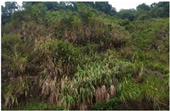 | 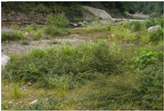 | |
References
- Gelot, S.; Bigard, C. Challenges to developing mitigation hierarchy policy: Findings from a nationwide database analysis in France. Biol. Conserv. 2021, 263, 109343. [Google Scholar] [CrossRef]
- Robertson, M.M. No net loss: Wetland restoration and the incomplete capitalization of nature. Antipode 2000, 32, 463–493. [Google Scholar] [CrossRef]
- Ruhl, J.B.; Salzman, J. Gaming the past: The theory and practice of historic baselines in the administrative state. Vand. L. Rev. 2011, 64, 1. [Google Scholar] [CrossRef]
- Maron, M.; Ives, C.D.; Kujala, H.; Bull, J.W.; Maseyk, F.J.; Bekessy, S.; Evans, M.C. Taming a wicked problem: Resolving controversies in biodiversity offsetting. BioScience 2016, 66, 489–498. [Google Scholar] [CrossRef]
- BBOP. Guidance Notes to the Standard on Biodiversity Offsets; BBOP: Washington, DC, USA, 2012. [Google Scholar]
- Bull, J.W.; Brauneder, K.; Darbi, M.; Van Teeffelen, A.J.; Quétier, F.; Brooks, S.E.; Strange, N. Data transparency regarding the implementation of European ‘no net loss’ biodiversity policies. Biol. Conserv. 2018, 218, 64–72. [Google Scholar] [CrossRef]
- Hough, P.; Robertson, M. Mitigation under Section 404 of the Clean Water Act: Where it comes from, what it means. Wetl. Ecol. Manag. 2009, 17, 15–33. [Google Scholar] [CrossRef]
- Ekstrom, J.; Bennun, L.; Mitchell, R. A Cross-Sector Guide for Implementing the Mitigation Hierarchy; Cross Sector Biodiversity Initiative; The Biodiversity Consultancy Ltd.: Cambridge, UK, 2015. [Google Scholar]
- Phalan, B.; Hayes, G.; Brooks, S.; Marsh, D.; Howard, P.; Costelloe, B.; Whitaker, S. Avoiding impacts on biodiversity through strengthening the first stage of the mitigation hierarchy. Oryx 2018, 52, 316–324. [Google Scholar] [CrossRef]
- Dorney, J.; Savage, R.; Tiner, R.W.; Adamus, P. (Eds.) Wetland and Stream Rapid Assessments: Development, Validation, and Application; Academic Press: Cambridge, MA, USA, 2018. [Google Scholar]
- Adamus, P.R. A Method for Wetland Functional Assessment: Volume II FHWA Assessment Method; United States Department of Transportation: Washington, DC, USA, 1983.
- Smith, R.D.; Ammann, A.; Bartoldus, C.; Brinson, M.M. An Approach for Assessing Wetland Functions Using Hydrogeomorphic Classification, Reference Wetlands, and Functional Indices; Technical Report WRP-DE-9; U.S. Army Engineer Waterways Experiment Station: Vicksburg, MS, USA, 1995. [Google Scholar]
- Adamus, P. Manual for the Wetland Ecosystem Services Protocol for the United States (WESPUS) Version 1.0; Adamus Resource Assessment Inc.: Corvallis, OR, USA, 2011; p. 62. Available online: https://www.novascotia.ca/nse/wetland/docs/manual_wespus.pdf (accessed on 1 February 2023).
- Government of Alberta. Alberta Wetland Rapid Evaluation Tool-Actual (ABWRET-A) Manual. Water Policy Branch; Alberta Environment and Parks: Edmonton, AB, Canada, 2015; p. 150. Available online: https://open.alberta.ca/dataset/0fd47f30-d3ee-4b2f-83ac-e96a6499d7ce/resource/ea9e44bd-0ed4–4cdd-94cc-8f5b27f21c8a/download/2015-alberta-wetland-rapid-evaluation-tool-actual-abwret-a-guide-june-2015.pdf (accessed on 1 February 2023).
- Rooney, R.C.; Royall, O.; Robinson, D.T.; Cobbaert, D.; Trites-Russell, M.; Wilson, M. Evaluating the development and use of a rapid wetland assessment tool (ABWRET-A) in policy implementation in Alberta, Canada. Environ. Sci. Policy 2022, 136, 575–587. [Google Scholar] [CrossRef]
- Government of Ontario. Ontario Wetland Evaluation System Southern Manual, 3rd ed.; Queen’s Printer for Ontario: Toronto, ON, Canada, 2014; p. 296, Version 3.3; Available online: https://files.ontario.ca/environment-and-energy/parks-and-protected-areas/ontario-wetland-evaluation-system-southen-manual-2014.pdf (accessed on 3 February 2023).
- Anon, Nova Scotia Environment. Nova Scotia Wetland Evaluation Technique; Version 3.0; Nova Scotia Environment, Government of Nova Scotia: Halifax, NS, Canada, 2011; Available online: https://novascotia.ca/nse/wetland/assessing.wetland.function.asp (accessed on 14 February 2023).
- Gerakis, A.; Kalburtji, K. Agricultural activities affecting the functions and values of Ramsar wetland sites of Greece. Agric. Ecosyst. Environ. 1998, 70, 119–128. [Google Scholar] [CrossRef]
- Gallaway, S.; Davis, C.; Dvorett, D.; Tramell, B. Validation of the Oklahoma Rapid Assessment Method (OKRAM) in depressional wetlands using EPA’s three-tiered framework. Wetlands 2020, 40, 925–937. [Google Scholar] [CrossRef]
- Gaucherand, S.; Schwoertzig, E.; Clement, J.C.; Johnson, B.; Quétier, F. The cultural dimensions of freshwater wetland assessments: Lessons learned from the application of US rapid assessment methods in France. Environ. Manag. 2015, 56, 245–259. [Google Scholar] [CrossRef]
- Bezombes, L.; Kerbiriou, C.; Spiegelberger, T. Do biodiversity offsets achieve No Net Loss? An evaluation of offsets in a French department. Biol. Conserv. 2019, 231, 24–29. [Google Scholar] [CrossRef]
- Bigard, C.; Pioch, S.; Thompson, J.D. The inclusion of biodiversity in environmental impact assessment: Policy-related progress limited by gaps and semantic confusion. J. Environ. Manag. 2017, 200, 35–45. [Google Scholar] [CrossRef] [PubMed]
- Weissgerber, M.; Roturier, S.; Julliard, R.; Guillet, F. Biodiversity offsetting: Certainty of the net loss but uncertainty of the net gain. Biol. Conserv. 2019, 237, 200–208. [Google Scholar] [CrossRef]
- Larsen, S.V.; Kørnøv, L.; Christensen, P. The mitigation hierarchy upside down–a study of nature protection measures in Danish infrastructure projects. Impact Assess. Proj. Apprais. 2018, 36, 287–293. [Google Scholar] [CrossRef]
- Persson, J.; Larsson, A.; Villarroya, A. Compensation in Swedish infrastructure projects and suggestions on policy improvements. Nat. Conserv. 2015, 11, 113–127. [Google Scholar] [CrossRef]
- Lindenmayer, D.B.; Crane, M.; Evans, M.C.; Maron, M.; Gibbons, P.; Bekessy, S.; Blanchard, W. The anatomy of a failed offset. Biol. Conserv. 2017, 210, 286–292. [Google Scholar] [CrossRef]
- Quigley, J.T.; Harper, D.J. Effectiveness of fish habitat compensation in Canada in achieving no net loss. Environ. Manag. 2006, 37, 351–366. [Google Scholar] [CrossRef]
- Dillabaugh, K.A.; King, D.J. Riparian marshland composition and biomass mapping using Ikonos imagery. Can. J. Remote Sens. 2008, 34, 143–158. [Google Scholar] [CrossRef]
- Hunter, S.B.; zu Ermgassen, S.O.E.; Downey, H.; Griffiths, R.A.; Howe, C. Evidence shortfalls in the recommendations and guidance underpinning ecological mitigation for infrastructure developments. Ecol. Solut. Evid. 2021, 2, e12089. [Google Scholar] [CrossRef]
- Reeves, R.A.; Pierce, C.L.; Smalling, K.L.; Klaver, R.W.; Vandever, M.W.; Battaglin, W.A.; Muths, E. Restored agricultural wetlands in central Iowa: Habitat quality and amphibian response. Wetlands 2016, 36, 101–110. [Google Scholar] [CrossRef]
- Maron, M.; Brownlie, S.; Bull, J.W.; Evans, M.C.; von Hase, A.; Qu’etier, F.; Watson, J.E.M.; Gordon, A. The many meanings of no net loss in environmental policy. Nat. Sustain. 2018, 1, 19–27. [Google Scholar] [CrossRef]
- Maragos, J.E.; Cook, C.W., Jr. The 1991–1992 rapid ecological assessments of Palau’s coral reefs. Coral Reefs 1995, 14, 237–252. [Google Scholar] [CrossRef]
- Sayre, R.; Roca, E.; Sedaghatkish, G.; Young, B.; Keel, S.; Roca, R.; Sheppard, S. Nature in focus: Rapid Ecological Assessment; Island Press: Washington, DC, USA, 2000. [Google Scholar]
- Ramsar Convention, SC43-23: An Integrated Framework for Avoiding, Mitigating and Compensating for Wetland Losses. 2011. Available online: www.ramsar.org/sites/default/files/documents/pdf/sc/43/sc43-doc23-avoid.pdf (accessed on 15 March 2023).
- Public Works Committee. Executive Yuan, Friendly Information Disclosure Platform. Available online: www.pcc.gov.tw/Content_List.aspx?n=1FC734786BD98077 (accessed on 15 March 2023).
- Public Works Committee. Executive Yuan, Public Works Ecological Inspection Area. Available online: www.pcc.gov.tw/Content_List.aspx?n=8BDF8E919EB3E6A9 (accessed on 15 March 2023).
- Public Works Committee. Executive Yuan, Handling of Ecological Inspection. Available online: www.pcc.gov.tw/Content_List.aspx?n=8F1B7698DDB3EA97 (accessed on 15 March 2023).
- Water Conservancy Administration, Ministry of Economic Affairs, Forward-Looking Basic Construction Design-Water Environment Construction Administrative Transparency Exclusive Website-ecological Inspection. Available online: Flwe.wra.gov.tw/cp.aspx?n=26073 (accessed on 15 March 2023).
- Forestry Bureau, Council of Agriculture, Executive Yuan, State-owned Forest Land Management Engineering Information Network–Management Engineering Query. Available online: Ecofrieng.forest.gov.tw (accessed on 15 March 2023).
- Ministry of Economic Affairs, Water Resources Agency, Implementation Reference Manual for Ecological Inspection of Reservoir Watershed Projects, Taipei, Republic of China (Taiwan), 2020. p. 58, (In Chinese). Available online: https://www-ws.wra.gov.tw/Download.ashx?u=LzAwMS9VcGxvYWQvNDMwL3JlbGZpbGUvOTkxMy8xMDc2Mi9jZDBlOWYyNC1lNDhhLTRlM2QtODVhMy0xZWIxNTE5NjE1MDAucGRm&n=57aT5r%2Bf6YOo5rC05Yip572y5rC05bqr6ZuG5rC05Y2A5bel56iL55Sf5oWL5qqi5qC45Z%2B36KGM5Y%2BD6ICD5omL5YaKLTEwOTA0LnBkZg%3D%3D (accessed on 10 March 2023).
- Costanza, R.; d’Arge, R.; De Groot, R.; Farber, S.; Grasso, M.; Hannon, B.; Van Den Belt, M. The value of the world’s ecosystem services and natural capital. Nature 1997, 387, 253–260. [Google Scholar] [CrossRef]
- Plafkin, J.L.; Barbour, M.T.; Porter, K.D.; Gross, S.K.; Hughes, R.M. Rapid Bioassessment Protocols for Use in Streams and Rivers: Benthic Macroinvertebrates and Fish; EPA 444/4-89-001; US EPA, Off. Water: Washington, DC, USA, 1989.
- Barbour, M.T.; Gerritsen, J.; Snyder, B.D.; Stribling, J.B. Rapid Bioassessment Protocols for Use in Streams and Wadeable Rivers: Periphyton, Benthic Macroinvertebrates and Fish, 2nd ed.; EPA/841-B-99-002; US EPA, Off. Water: Washington, DC, USA, 1999.
- Chen, Z.H.; Zheng, X.H.; Peng, X.Y.; Lin, X.H. Analysis and Research on Applicable Evaluation Factors for Vegetation Restoration in Collapsed Land. J. Chin. Soil Water Conserv. 2010, 41, 296–307. (In Chinese) [Google Scholar]

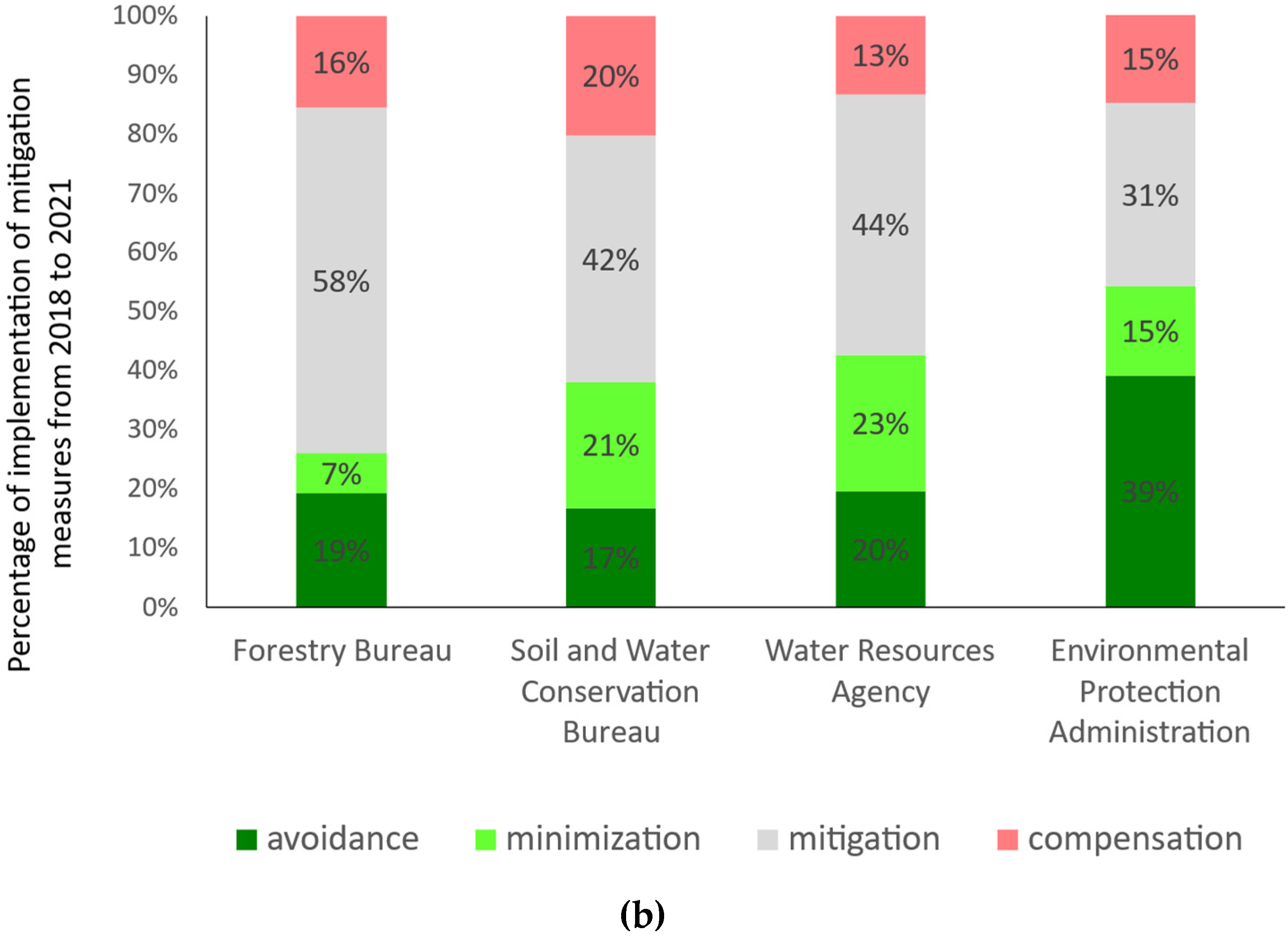




| Indicators | Ecosystem Services |
|---|---|
| Ecological concern areas (Ia) | Gas regulation |
| Climate regulation | |
| Water regulation | |
| Disturbance regulation | |
| Water supply | |
| Erosion control and sediment retention | |
| Refugia | |
| Pollination | |
| Genetic resources | |
| Recreation | |
| Number of ecological conservation measures (Im) | Refugia |
| Genetic resources | |
| Soil formation | |
| Nutrient cycling | |
| Waste treatment | |
| Cultural | |
| Number of ecological conservation objects (Io) | Biological control |
| Refugia | |
| Genetic resources | |
| Cultural | |
| Quality of habitat (Ih) | Gas regulation |
| Climate regulation | |
| Water regulation | |
| Soil formation | |
| Nutrient cycling | |
| Disturbance regulation | |
| Water supply | |
| Erosion control and sediment retention Refugia | |
| Genetic resources |
| Indicator | Points | 10 | 8 | 5 | 3 | 0 |
|---|---|---|---|---|---|---|
| Ecological concern areas | (%) | 0 | 0–25 | 26–50 | 51–75 | 76–100 |
| Number of ecological conservation measures | Im | ≥4 | 3 | 2 | 1 | 0 |
| Number of ecological conservation objects | Io | ≥4 | 3 | 2 | 1 | 0 |
| Indicator of Habitat Quality (Ih) | Subparameters | Definition | Points |
|---|---|---|---|
| River habitat | 1. Epifaunal Substrate/Available Cover 2. Embeddedness 3. Velocity/Depth Regime 4. Sediment Deposition 5. Channel Flow Status 6. Channel Alteration 7. Frequency of Riffles (or bends) 8. Bank Stability (score each bank) 9. Vegetation Protection (score each bank) 10. Riparian Vegetative Zone Width (score each bank riparian zone) | All parameter values after construction ≥ parameter value before construction | 10 |
| N parameter values after construction < parameter value before construction | 10–0.5 N * | ||
| All parameter values after construction < parameter value before construction | 5 | ||
| Slope land habitat | 1. Percentage of woody plant coverage (%) 2. Number of plant species (number/100 m2) 3. Native plant coverage (%) 4. Structure layers of plant community %. Succession stage data | The total score after construction > the total score before construction | 10 |
| The total score after construction = the total score before construction | 9 | ||
| The total score after construction < the total score before construction | 5 |
| Indicators | n | Ia | Im | Io | Ih | Total Points | |
|---|---|---|---|---|---|---|---|
| Construction Types | |||||||
| River conservation | 17 | 5.88 ± 4.55 | 10.00 ± 0.00 | 2.06 ± 3.29 | 2.97 ± 3.35 | 20.91 ± 5.54 | |
| Slope land conservation | 11 | 7.64 ± 3.88 | 10.00 ± 0.00 | 1.18 ± 2.09 | 0.00 ± 0.00 | 18.82 ± 4.85 | |
| River and reservoir dredging | 8 | 9.25 ± 1.04 | 8.88 ± 1.81 | 3.25 ± 3.65 | 4.69 ± 4.07 | 26.06 ± 7.91 | |
| Structure improvement | 6 | 10.00 ± 0.00 | 9.67 ± 0.82 | 3.83 ± 2.04 | 0.00 ± 0.00 | 23.50 ± 2.35 | |
| Others | 12 | 8.00 ± 3.81 | 8.67 ± 2.35 | 2.17 ± 3.59 | 3.48 ± 4.37 | 22.31 ± 9.55 | |
| Total | 54 | 7.67 ± 3.78 | 9.50 ± 1.41 | 2.28 ± 3.10 | 2.40 ± 3.54 | 21.85 ± 6.93 | |
| Species | Fish | Birds | Mammals | Plants | Protected Forests | |
|---|---|---|---|---|---|---|
| Construction Types | ||||||
| River conservation | 0 | 1 | 4 | 4 | 2 | |
| Slope land conservation | 0 | 0 | 0 | 0 | 2 | |
| River and reservoir dredging | 0 | 0 | 0 | 0 | 3 | |
| Structure improvement | 0 | 1 | 0 | 4 | 1 | |
| Others | 0 | 0 | 3 | 5 | 3 | |
| Method | Features | Reference |
|---|---|---|
| WET |
| [11,18] |
| NovaWET 3.0 |
| [17] |
| WESPUS |
| [13] |
| ABWRET-A |
| [14,15] |
| OWES |
| [16,28] |
| This study |
|
Disclaimer/Publisher’s Note: The statements, opinions and data contained in all publications are solely those of the individual author(s) and contributor(s) and not of MDPI and/or the editor(s). MDPI and/or the editor(s) disclaim responsibility for any injury to people or property resulting from any ideas, methods, instructions or products referred to in the content. |
© 2023 by the authors. Licensee MDPI, Basel, Switzerland. This article is an open access article distributed under the terms and conditions of the Creative Commons Attribution (CC BY) license (https://creativecommons.org/licenses/by/4.0/).
Share and Cite
Tsai, Y.-W.; Lin, J.-Y.; Chen, C.-F. Assessing the Effectiveness of Ecological Mitigation Practices in Public Construction with a Quick and Operational Assessment Framework. Sustainability 2023, 15, 7480. https://doi.org/10.3390/su15097480
Tsai Y-W, Lin J-Y, Chen C-F. Assessing the Effectiveness of Ecological Mitigation Practices in Public Construction with a Quick and Operational Assessment Framework. Sustainability. 2023; 15(9):7480. https://doi.org/10.3390/su15097480
Chicago/Turabian StyleTsai, Yie-Wen, Jen-Yang Lin, and Chi-Feng Chen. 2023. "Assessing the Effectiveness of Ecological Mitigation Practices in Public Construction with a Quick and Operational Assessment Framework" Sustainability 15, no. 9: 7480. https://doi.org/10.3390/su15097480
APA StyleTsai, Y.-W., Lin, J.-Y., & Chen, C.-F. (2023). Assessing the Effectiveness of Ecological Mitigation Practices in Public Construction with a Quick and Operational Assessment Framework. Sustainability, 15(9), 7480. https://doi.org/10.3390/su15097480








